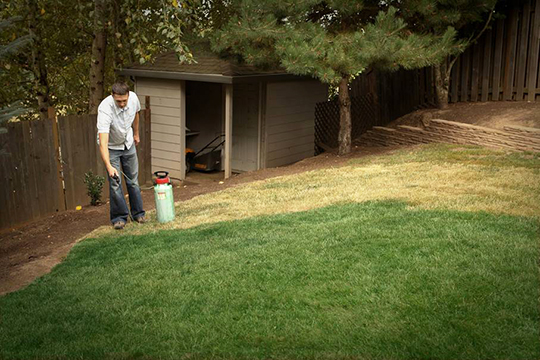If the grass is always greener on the other side of the fence, your neighbor may be painting their lawn, a quick fix for drought-damaged turf.
Lawn painting isn’t new: Groundskeepers at golf courses and football fields have been touching up brown grass spots with paint for decades. Now, drought and water restrictions are forcing lawn-loving home owners to find non-water ways to keep their grass green, and lawn painting is an increasingly popular alternative.
“Business is through the roof,” says Dave Delatorre, owner of LawnLift grass paint, which sells lawn paint to home owners and landscapers running out of options.
Related: Gorgeous Drought-Resistant Plants
Lawn Paint Specs
Lawn paint is made from nontoxic and biodegradable ingredients that cling to grass blades — and anything else you spray it on. Most lawn paint is made from pulverized kaolin, a soft stone; some is made from decayed plants.
Lawn paint is harmless to humans and pets, is colorfast when dry, and won’t contaminate the watershed. It’ll last for two to three months, depending on how quickly your lawn grows and how often you mow it.
Thick, dormant grass — its roots are still good and the grass will green up again when rain resumes — takes lawn paint best. You can paint dead grass, but dead blades are brittle and likely to snap off and blow away, leaving ugly patches of brown dirt.
DIY Grass Paint Application
With a couple of bottles of grass paint and a garden sprayer, you can paint your lawn yourself. A 16-ounce bottle of concentrated grass paint ($25) will cover 300 square feet. Mix with water and spray.
For best results:
- Lawn should be mowed and dry.
- Weather should be sunny and windless.
- Spray wand should be set on a fine mist.
- Test color on a hidden spot before spraying. Add water to lighten the color.
- Spray in a circular pattern and plan on a second coat to get a richer color.
Grass paint will stain driveways, fence posts, pavers, and garden mulch, so protect surrounding areas with plastic sheeting and masking tape, and spray carefully. Scrub off mistakes with a wire brush and an ammonia-based window cleaner.
Professional Application
DIY is worth it since pros charge $200 to $500 for two coats on 2,000 sq. ft. But if you prefer the pro route, do an online search for “lawn care services” and “lawn maintenance” in your area.
Related: Do Home Remedies Work for Organic Lawn Care?
Lawn Painting Tips
1. To avoid staining yourself green, wear gloves, a facemask, goggles, and protective clothing when spraying.
2. You can make your own grass paint from Epsom salt, fertilizer, and green food coloring. Epsom salt adds magnesium, so test your soil before painting to make sure your lawn needs the added nutrients.
3. Don’t use homemade lawn paint during a heat wave, because the fertilizer base will stress grass even more. Instead, use this paint for fall or winter touchups.
4. Painted lawns still must be watered deeply once a week to keep roots alive.
Related: Early Spring Lawn Care Tips to Revive Your Frozen Turf
